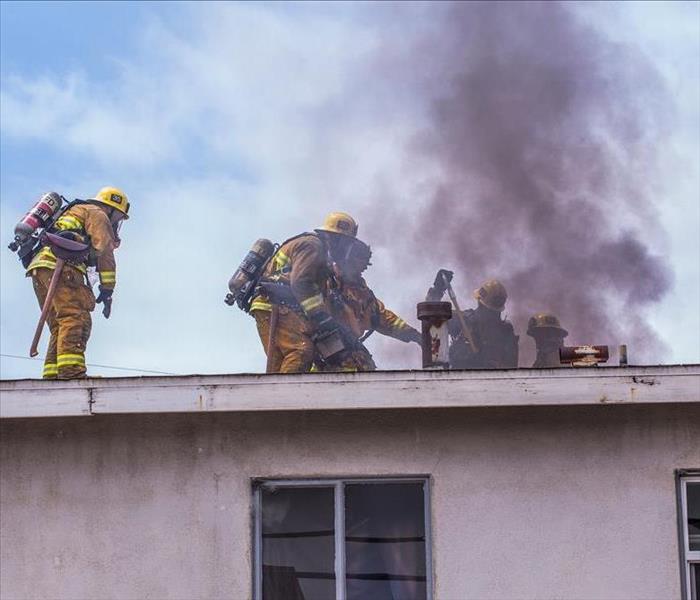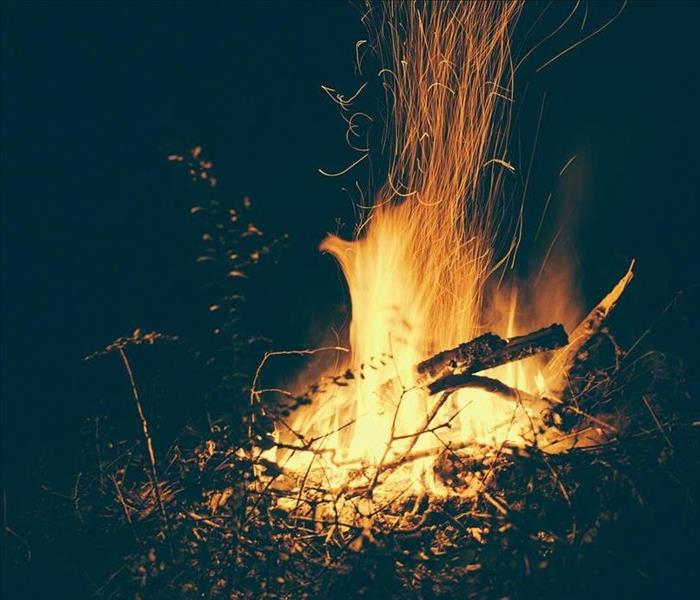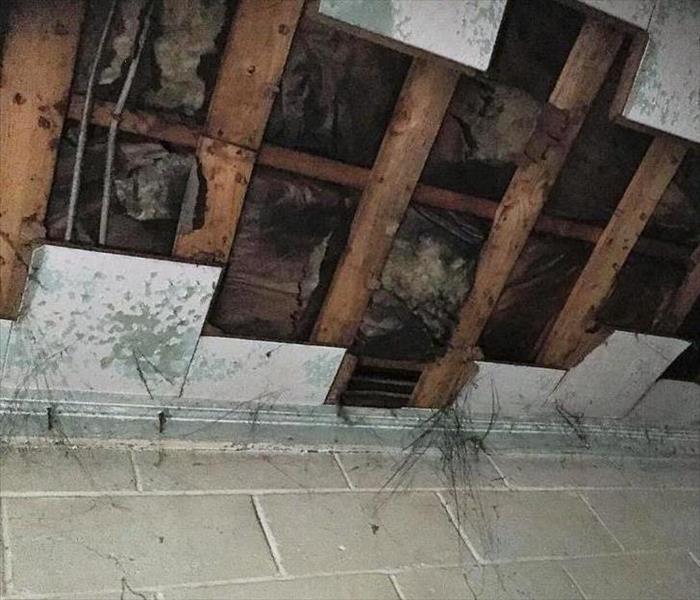Recent Fire Damage Posts
Space Heater Safety tips
12/6/2024 (Permalink)
Here are some important space heater fire safety tips to help keep your home and family safe this winter:
1. Keep Flammable Objects Away
- Keep space heaters at least 3 feet away from anything that can catch fire, including curtains, furniture, blankets, and papers.
2. Turn Off When Not in Use
- Never leave a space heater running unattended. Always turn it off when you leave the room or go to bed.
3. Use the Right Heater for the Room
- Ensure your space heater is rated for the size of the room you're heating. Avoid using a heater that is too powerful for a small space or too weak for a large room.
4. Place Heaters on a Flat, Stable Surface
- Always place space heaters on a flat, level surface. Avoid placing them on soft surfaces like carpets or beds, which can increase the risk of tipping.
5. Inspect Before Use
- Check your space heater's cord, plug, and wiring for any damage before use. Never use a heater with a frayed or exposed cord.
6. Use Only Approved Heaters
- Only use space heaters that have been tested and approved by safety standards, such as those from UL (Underwriters Laboratories).
7. Avoid Extension Cords
- Plug space heaters directly into the wall socket. Avoid using extension cords, as they can overheat and increase the risk of fire.
8. Keep Children and Pets Away
- Keep space heaters out of reach of children and pets to prevent burns or accidents from touching hot surfaces.
9. Check the Heating Area
- Make sure the area around the heater is clear of dust, dirt, and pet hair, as these can catch fire when heated.
10. Choose a Heater with Safety Features
- Look for space heaters with automatic shut-off features that turn the unit off if it tips over or overheats.
By following these space heater safety tips, you can enjoy the warmth and comfort of your space heater without compromising safety. Stay warm and safe this winter!
Grease Fire and The Holidays
11/2/2023 (Permalink)
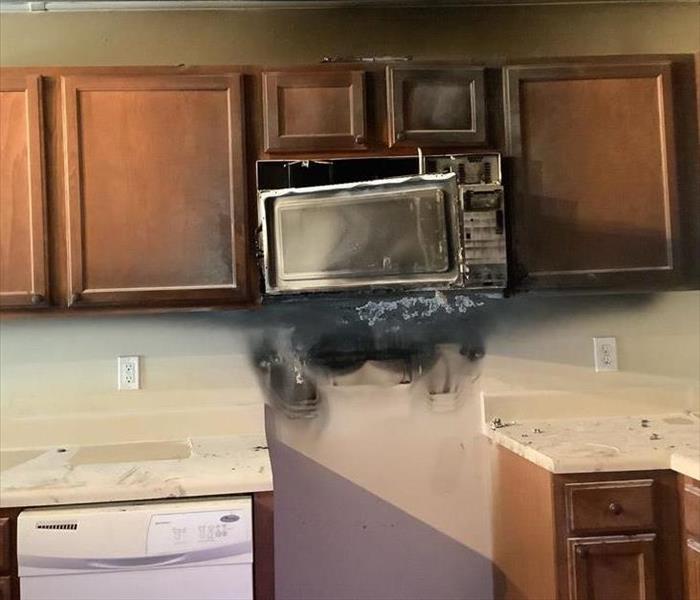 Grease fire aftermath, 2022
Grease fire aftermath, 2022
These are important safety tips for anyone cooking with hot oil, especially during the holiday season when deep frying is common. Here's a summary of those tips for a safe and enjoyable cooking experience:
When Cooking with Hot Oil:
Stay in the Kitchen: Never leave the stove or deep fryer unattended while it's in use. Most grease fires occur when people step away from the kitchen.
Heat the Oil Gradually: Slowly heat the oil to the desired temperature to avoid overheating, which can lead to fires.
Monitor the Temperature: If you suspect the oil is getting too hot, turn off the burner to prevent it from igniting.
Careful Placement: Gently place food into the hot grease to prevent splattering and burns.
Fire Safety: If a grease fire starts, immediately use a fire-smothering method. Options include using a pan lid, cookie sheet, cat litter, a fire extinguisher, flour, or a wet cloth to extinguish the flames.
Avoid These Actions:
Don't Carry the Pan Outside: Moving a burning pan outside can be dangerous and may cause severe injuries. It's best to handle the fire right where it started.
Avoid Panicking: Panicking can lead to poor decisions, like splashing the grease or knocking over the pan. Stay calm and act quickly but with caution.
Don't Use Water or Dry Cloths: Water should never be used to extinguish a grease fire, as it can cause the fire to spread. Dry cloths are also not effective. Use the recommended fire-smothering methods mentioned earlier.
Special Consideration for Turkey Fryers:
When using turkey fryers, it's essential to follow specific safety precautions:
Outdoor Use: Always use turkey fryers outdoors, away from any structures or flammable materials. This reduces the risk of a fire spreading to your home.
Maintain Safe Distances: Ensure the fryer is placed on a stable, level surface and at a safe distance from any walls or structures.
Thaw the Turkey: Make sure the turkey is fully thawed and dried before lowering it into the hot oil. Ice or water on the bird can cause violent reactions when submerged in hot oil.
Use Appropriate Safety Gear: Wear appropriate safety gear, like oven mitts and safety goggles, when operating a turkey fryer.
By following these guidelines, you can reduce the risk of accidents and enjoy a safe and delicious holiday cooking experience. Remember to prioritize safety and be prepared for emergencies by keeping a fire extinguisher on hand. If a fire does occur, Call 911, and then call SERVPRO, we are hear to help.
Heating Equipment Safety
12/12/2022 (Permalink)
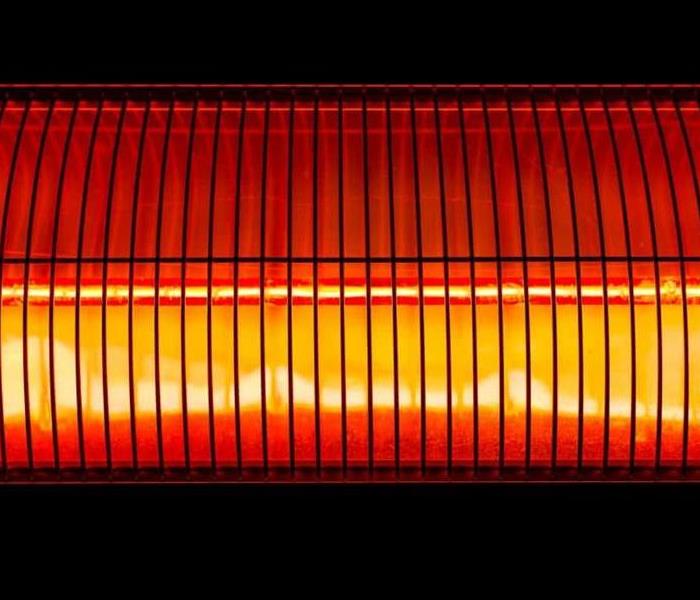 Any time you use heating equipment, it is important to talk about fire safety in order to decrease your property's fire risk.
Any time you use heating equipment, it is important to talk about fire safety in order to decrease your property's fire risk.
It’s getting to be that time of year again when the temperature starts to drop and we begin to feel a chill in the air. It is this time of year when many homeowners and business owners start thinking about turning on their property’s heating system. Any time we use heating equipment, it is important to talk about fire safety. In today’s blog, we’ll consider 3 statistical observations on the subject of heating safety risks from the National Fire Protection Agency and discuss ways in which you can prevent your property from becoming part of the statistics.
In a report based on annual averages between 2014 and 2018, the NFPA found that…
1. “Most home heating fire deaths (81%) involved stationary or portable space heaters.”
To prevent fires from portable heaters, be sure to keep them at least 3ft away from people and combustible objects, like blankets and upholstery.
2. “The leading factor contributing to home heating fires (25%) was failure to clean, principally from solid-fueled heating equipment, primarily chimneys.”
Chimneys and other solid-fueled heating systems should receive professional cleaning services on an annual basis. Getting into the habit of having your chimney inspected and cleaned once every year can help decrease your property’s fire risk.
3. “Nearly half (48%) of all home heating fires occurred in December, January and February.”
It can get extremely cold during the winter months, which makes it easy to want to keep portable heaters on 24/7. However, it is important to turn heaters off when you leave the room or go to bed, as fires can ignite when heaters are unsupervised.
Call SERVPRO Team Harloe for Fire Damage Restoration Services
Potential Fire Hazards and How To Prevent Them.
10/19/2021 (Permalink)
Potential Fire Hazards and How To Prevent Them.
No one ever believes a fire will start in their home, until it happens to them. Knowing what to expect in advance can help you prepare a plan. While a fire can start anywhere, at any time in your home, below is a list of the top four most common causes of fires and a few safety tips.
- Kitchen Fires: Your kitchen is the number one area in your home where a fire can start. Burning food, cooking with grease, small appliances, water, constant people in and out, or electrical problems are all factors that can cause a fire in your home. Grease fires can get out of control quickly, spreading to other areas of your home before the fire department has arrived. When cooking with grease, always exercise extreme caution. Keep a lid, baking soda, or fire extinguisher within reach just in case you need to smother a fire quickly. Never leave food unattended while you are cooking.
- Electrical Fires: are the second most common cause of house fire. Old or faulty wiring, broken or outdated breaker boxes, faulty appliances, or the improper use of outlets can cause a fire.
- Portable Heaters and Electric Blankets: can become hazards during the fall and winter seasons. If you are using a portable heater, always leave three feet of free space around the heater. Never place anything flammable on or near your heater. Whenever you leave the room, always turn it off. Even though modern electric blankets are considered generally safe, there are a few steps you can take to reduce your risk of a fire. Never plug electric blankets or heaters into power strips; always plug them into the outlet. Never use an electric blanket that has signs of excessive wear, such as tears, scorch marks, frayed cords, or damage temperature control. Avoid using an electric blanket that has wires and attachments that don't fit tightly.
- Smoking: is the fourth leading cause of fires. It is far more dangerous to smoke inside your home than outside. Many items in your home could catch on fire if they touched a lit cigarette or hot ashes. It does not take much for an ember to catch a chair, couch, rug, or curtains on fire. Always make sure you put your cigarette all the way out. Put water on ashes or butts or put cigarettes out in a bucket of sand.
- How Can You Prepare: While you can do everything in your power to prevent a fire in your home, sometimes accidents do happen. In these moments, you and your family's safety is the number one priority. The difference between safety and tragedy is preparation. Take the extra time to prepare yourself and your family now. Create a fire escape plan with your family. Map out at least two exit strategies for each area in your home. Designate a meeting spot that is a safe distance from your home that everyone knows where to meet once they escape. Practice as often as possible. Check your smoke alarms to ensure they are in working order. If your smoke alarms are ten years old or older, replace the entire unit. Install carbon monoxide detectors if you do not already have them in your home.
Don’t feel overwhelmed after a disaster - call SERVPRO of Pickens County at 864-855-3993. We respond immediately to any fire loss in an effort to mitigate the existing damage, prevent further secondary damage, and reduce restoration costs.
If You Have Fall Candles, Read This Before You Light Them.
10/11/2021 (Permalink)
If You Have Fall Candles, Read This Before You Light Them.
Fall is officially upon us. I know you are excited to decorate, prepare for thanksgiving, and enjoy all the activities that come with fall. As the weather gets cooler and the leaves begin to change into vibrant colors, nothing gets you in the fall spirit quite like burning your new fall-scented candles. Whether you are using these candles to create a cozy and charming atmosphere in your home or you are using them to jump-start the fall season in your home, never forget that open flames are potential fire hazards. According to the National Fire Protection Association (NFPA), the careless use of candles causes nearly 10,000 residential fires each year. Here are some helpful tips you can use to avoid fires caused by candles.
Candle Fire Safety Dos:
- Blow candles out whenever you leave the room or go to bed.
- Always burn your candles in well-ventilated rooms.
- Keep candles at least one foot away from anything flammable, such as paper, decorations, plants, and clothing.
- If you are using candle holders, always use sturdy candle holders that you know won't tip over easily. Place them on horizontal, stable, and heat-resistant surfaces.
- If you are burning multiple candles in an area, keep them at least three inches apart to ensure that they don’t melt one another.
- Keep candles out of the reach of children and pets. Always place them up high or in areas they cannot easily reach.
- Consider replacing burning candles with battery-operated flameless candles in your home. Most electrical candles look and smell like real candles.
Candle Fire Safety Don’ts:
- If you are in a small room, don’t burn too many candles. Limit yourself to burning only one candle in a small area.
- Don’t burn candles in rooms with vents, drafts, fans, or air currents to avoid rapid, uneven burning, flame flare-ups, and soot formation.
- Don’t use candles in bedrooms or other sleeping areas. Statistically, most fires started by candles occur in the bedroom. Opt for using a diffuser or flameless candles in bedrooms.
- Avoid burning candles all the way down to the bottom of the jar— put out candles when there are at least two inches of wax left or ½ inch if they are in a container.
- Don’t move candles while they’re burning. Hot wax can drip and cause injuries or severe burns. Extinguish candles before moving them or move them before lighting them.
- Avoid using candles during a power outage. Instead, use LED flameless candles, flashlights, or battery-powered lighting.
- Never use water to put out a candle to prevent hot wax from splashing. If your candle comes with a lid, never extinguish the flame by placing it on top of the burning candle. Use a candle snuffer to extinguish candles.
If you have fire or smoke damage caused by a candle and are unsure of what to do next, don't stress! Call SERVPRO of Pickens County (864) 855-3993. Our crewmembers have specialized equipment and resources that help them respond quickly and effectively to any fire emergency in the Pickens County community and surrounding areas.
Fall Fire Safety Tips You Can Use In Your Home!
10/5/2021 (Permalink)
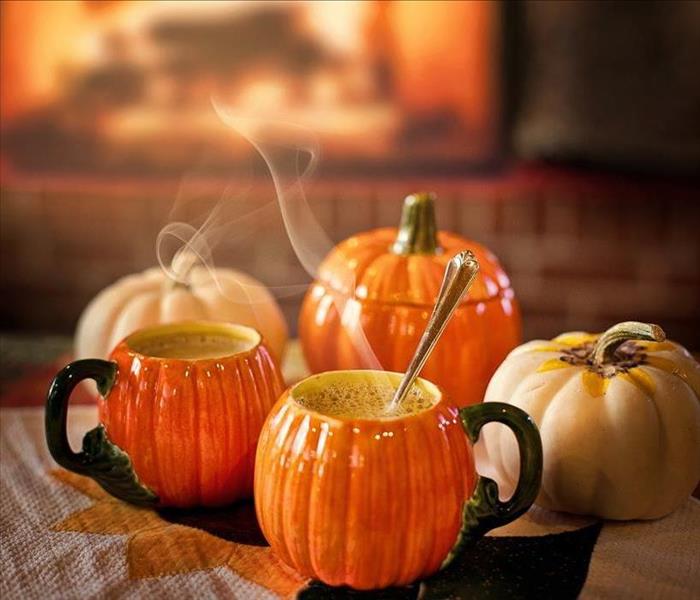 For professional fire damage repair and smoke remediation, call SERVPRO of Pickens County (864) 855- 3993.
For professional fire damage repair and smoke remediation, call SERVPRO of Pickens County (864) 855- 3993.
Fall Fire Safety Tips You Can Use In Your Home!
As the leaves change colors and the weather begins to cool down, you can start preparing for the fall and winter seasons ahead. You can't wait to start decorating your home and are excited to welcome your family and friends into your home for the upcoming holidays. Before you begin your holiday decoration and preparations, have you stopped to think about the fire safety risks that arise during the fall season? Below are a few fire safety tips to keep in mind during the fall:
- Change Smoke Alarm and Carbon Monoxide Detector Batteries and Test the Alarms. We all have a love/hate relationship with Daylight Savings Time. However, this is a great time to change the batteries in your smoke and carbon monoxide detector. By changing the batteries during Daylight Savings Time, you can ensure the alarms will not fail when you turn the heat on in your home. Make sure you test each smoke alarm when you change the batteries to check the smoke alarm is still working appropriately. If your smoke alarms are older than ten years, replace the entire unit. If you have fire extinguishers in your home, check that they are in working order when you change your clocks each season.
- Check and Service Your Heating Devices Before Turning On Your Heat:
- Your HVAC system needs to be inspected, clean, and serviced by a certified HVAC contractor. It is also a good idea to check and replace your furnace filters with high-efficiency particulate air (HEPA) filters.
- If you are using space heaters, allow at least three feet of space around the heater. I know it is tempting to place a towel, blanket, or article of clothing on a heater to warm it up on a chilly fall day but do not place fabrics or other flammable materials on space heaters. Always turn your heaters off before you go to bed.
- If your home has a fireplace, have your chimney inspected and cleaned by a professional chimney sweep. Utilize the three feet rule and keep flammable objects away from the fireplace. If you can, install a mesh metal screen around your fireplace.
- Halloween safety – We know you can't wait to decorate your home and begin costumes preparations for Halloween. Remember to keep decorations away from open flames and other heat sources, and use battery-operated lights instead of candles in jack-o-lanterns.
- Outdoor fire risks – As the leaves begin to fall, you may notice them and other debris building up around your home. Remember to cut back trees, rake leaves, and remove other flammable debris. When storing your lawnmower and other gas-powered tools for the fall and winter months, empty them of their fuel first. Keep your roof, gutters, and downspouts free of debris as well.
- Create a fire escape plan. The first step in being prepared is to have a plan. Did you know if a fire starts in your home, you have just two minutes to escape? It is vital you create a fire escape plan and practice it regularly. Create at least two designated escape routes for each area of your home. Pick a meeting spot outside that is a safe distance away from your home. Also, practice escaping your home staying low to avoid breathing in smoke. If you live in a multi-level home, practice getting out through windows using emergency ladders.
Follow these tips, and fire will not be able to ruin your fall! For professional fire damage repair and smoke remediation, call SERVPRO of Pickens County (864) 855- 3993. We will make it "Like it never even happened."
You Can Prevent Dryer Fires
7/7/2021 (Permalink)
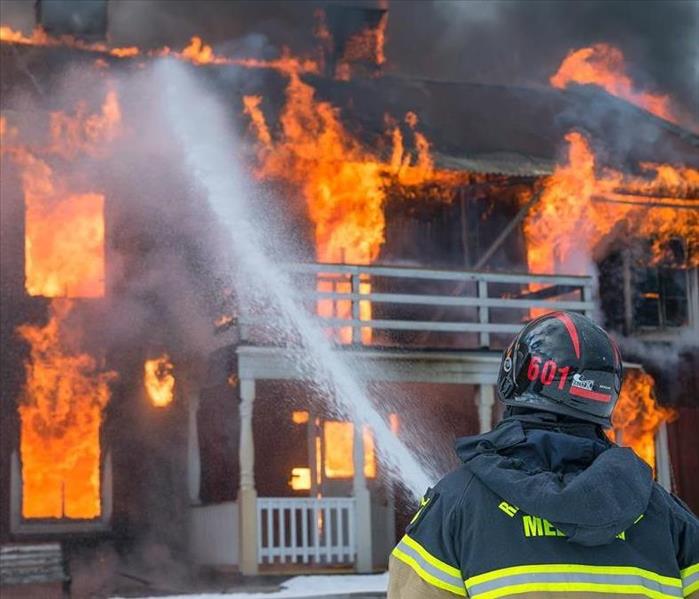 Dryer fires make up a large number of fires each year.
Dryer fires make up a large number of fires each year.
You Can Prevent Dryer Fires
Do you remember the last time you cleaned out your lint filter on your dryer? What about the exhaust vent or dryer duct? Hopefully, it was recently. There are several ways your dryer can become a potential hazard, and unfortunately, dryer fires make up a large number of fires each year. You can easily avoid a dryer fire with a few simple steps and preventative maintenance. Below we discuss the most common causes of dryer fires and how you can easily prevent them.
Causes of Dryer Fires
Mechanical and Electrical Failure:
Like anything with moving parts and electronic components, faulty wiring and damaged machinery can potentially start a dryer fire in your home. You should have these parts regularly checked and repaired if necessary.
Improper Use:
If you are using your dryer outside of the manufacturer's recommended guidelines, you could be in danger of starting a dryer fire in your home. You should never place items made out of plastic, rubber, foam or any items with instructions advising against drying with heat. You should also avoid overstuffing the dryer.
Dirty Lint Filters and Vents:
Clogged vents, ducts, and filters are the number one cause of dryer fires. Usually, this results from a buildup of lint, but a fire can start due to an accumulation of dirt, grass, or anything that remains after going through the washer. The outside filter can also be clogged, which restricts airflow and leads to hazardous conditions.
How To Prevent Dryer Fires
Make Sure Your Dryer Is Properly Installed:
If you do not install your dryer correctly, it can lead to a plethora of complications or a fire. Many stores offer in-home installation; always take advantage of that whenever possible.
You need to plug your dryer into a 240-volt electrical outlet. Plugging a dryer into a 120-volt outlet could cause several problems. You need to make sure the ventilation duct is attached securely to the dryer and to the exterior exhaust vent. When placing your dryer in your home, make sure it is not too close to other appliances or shelves.
Clean The Lint Filter After Each Use:
Heat can build up in a dryer if there is not adequate or proper airflow. The lint filter is the primary place blockages occur. When you don't clean the lint out of the filter, lint builds up in the filter and creates a tinder bundle that can cause a fire. Always clean the lint filter out after every load of laundry.
Clean The Vent and Duct:
Over time lint can sneak past the lint filter and build up inside the duct between the dryer and exterior vent outside your home. If you notice your clothes are taking longer to dry or they aren't drying completely, you may have an obstruction in your venting system. Additionally, if you smell a burning smell coming from your dryer or if you notice that your clothes and the outside of the dryer are too hot, stop the dryer immediately, unplug the dryer and check the duct and vent after they have had a chance to cool down. It is recommended you clean the dryer duct once every three months. You should regularly check your outside vent for clogs or other obstructions.
Use Your Dryer Correctly:
Pay close attention to product labels and instructions for washing a drying. Not only could you ruin the item, but you could cause a fire. Your clothes that are soiled with flammable compounds like gas, oil, or alcohol do not need to go in the dryer, as the heat can set them on fire. Wash them multiple times in the washer and then dry them on a clothesline or drying rack. Finally, never run your dryer while you are sleeping or are out of the house.
If your dryer starts a fire in your home - don't panic! After the first responders leave, call SERVPRO of Pickens County (864) 855 - 3993. We will make it "Like it never even happened."
I Used A Fire Extinguisher In My House How Do I Clean Up The Residue?
6/21/2021 (Permalink)
I Used A Fire Extinguisher In My House How Do I Clean Up The Residue?
Being prepared for a fire can make the difference between dealing with a huge disaster or a mess. Having a portable fire extinguisher within reach is a fast and effective response for when a minor fire breaks out in your home. If a fire does begin in your home and you put it out with a portable fire extinguisher, unfortunately, you will be left with a slight mess to clean up. The chemicals used in various fire extinguishers are hazardous to humans and pets so, all of the fire extinguishers' dust and residue must be removed and cleaned. ABC multi-purpose fire extinguishers contain either ammonium phosphate or ammonium sulfate powder that is irritating to the eyes, skin, and lungs. Before you begin cleaning up, you need to identify the dousing agent. An air pressurized water fire extinguisher or CO2 fire extinguishers won't leave behind any harmful chemicals. All fire extinguishers will have a label or tag that tells you what type of fire extinguishers it is and what it contains.
Before you begin cleaning any fire extinguisher residue, you must remember to wear protective gear. Wear an n95 dust mask, goggles, and nitrile gloves to avoid a potential allergic reaction. A dry chemical fire extinguisher with non-toxic bicarbonate will leave behind a powdery residue. You can easily clean the left-behind powdery residue with a vacuum and a few simple steps. First, remove any large debris left behind after the fire. Once you have removed all the big debris, you can begin going over the area with a vacuum. It may take several passes with the vacuum to thoroughly remove all the powdery residue. If the space you are cleaning is for food prep or cooking space, it's crucial you thoroughly clean and sanitize the area after removing the residue.
A multi-purpose dry chemical fire extinguisher containing mono ammonium phosphate requires a different method of cleaning. You will not be able to vacuum up the left behind residue. You must quickly remove this residue by hand. Wear nitrile gloves and wipe the leftover residue with a clean cloth. If you can wet-wash the surface, use a 1:1 solution of warm water and baking soda. Thoroughly dry and sanitize the area once you have cleaned up all the residue.
If you have fire extinguisher residue and can't clean it up, give SERVPRO of Pickens County a call (864) 855 - 3993. Our top-of-the-line technology and cleaning products paired with our highly trained technicians will make it "Like it never even happened."
Safety First Before the Feast!
11/13/2020 (Permalink)
Safety First Before the Feast!
Each November, families come together and gather around the table to feast on a delicious Thanksgiving meal. Thanksgiving is the peak day for home cooking fires, and if you don't practice safe cooking habits, your happy holidays could quickly become hazardous in the blink of an eye. If you plan on using a turkey fryer during this holiday season, check out these tips we've put together.
- Turkey fryers can easily tip over and spill hot oil across a large area. Only use your turkey fryer outdoors and on a stable level area well away from anything that can burn.
- Establish a 3-foot kid-free and pet-free zone. Tiny hands and paws can cause spills and burn injuries.
- Do not overfill your turkey fryer; oil will spill out when the turkey is cooking. To determine the right amount of cooking oil, place the turkey in the fryer with water first.
- Never out a frozen turkey in the fryer. Always thaw your turkey before attempting to fry it.
- Turkey fryers can overheat. Make sure to check the temperature with a cooking thermometer so the oil won't overheat.
- Always use long cooking gloves when handling the pot, lid, or handles of the turkey fryer.
If the unthinkable happens and fire strikes in your Pickens County home, give the experts at SERVPRO of Pickens County a call (864) 855-3993. We will help make it "Like it never even happened."
Planning a Bonfire This Fall? Check Out These Tips First.
10/8/2020 (Permalink)
Relaxing around a fire pit during a chilly fall night is one of the best ways to end a barbeque, a night of camping, or get together. Whether you are in the comfort of your backyard or relaxing at a campsite, these firepit safety tips can help keep you and your friends stay safe this fall.
- Choose the right location: First, find a level and open area to have your fire. Your fire pit needs to be at least ten feet from structures or items that can catch fire.
- Pick the right fuel: If you're looking to enjoy an authentic fire accompanied by cracking and popping sounds, then a wood-burning fire is the best choice. For a quick lighting option, opt for a gas or propane pit. However, if you cant make your mind up, many store-bought fire pits allow you to switch between wood and gas.
- Use the right wood: Always burn seasoned hardwoods. Materials like plywood can release toxic fumes, while softwoods can spark and pop excessively. Only use woods that fit entirely in your fire pit and do not stick out.
- Don't use fuel accelerants: Using fire accelerants can be extremely dangerous. Fire starters can release toxic fumes, start an explosion, or cause your fire to grow too rapidly.
- Add a screen: Using a fire pit screen is the best way to protect yourself and guests from embers and sparks that could ignite clothing or other materials. Choose a screen that has a heat resistant metal like steel or cast iron.
- Check the weather and burn status: Wind can cause your fire to spread rapidly. If pollution levels are high, your local government may issue a burn ban to limit particulate matter and keep carbon dioxide levels down. Check both of these things before starting a fire.
- Be smart around a fire: Avoid wearing flowy clothing or drinking excessively when around a fire pit. Always have an adult present if children are around the fire pit.
- Extinguish the fire correctly: Make sure your fire is completely out by drowning the fire pit in water and then mixing the ashes and ember with the soil. Scrape partially burned logs to ensure the hot embers are off of them. Then, stir the embers to make sure everything is wet.
Fire Prevention Tips For Fall and Winter!
10/6/2020 (Permalink)
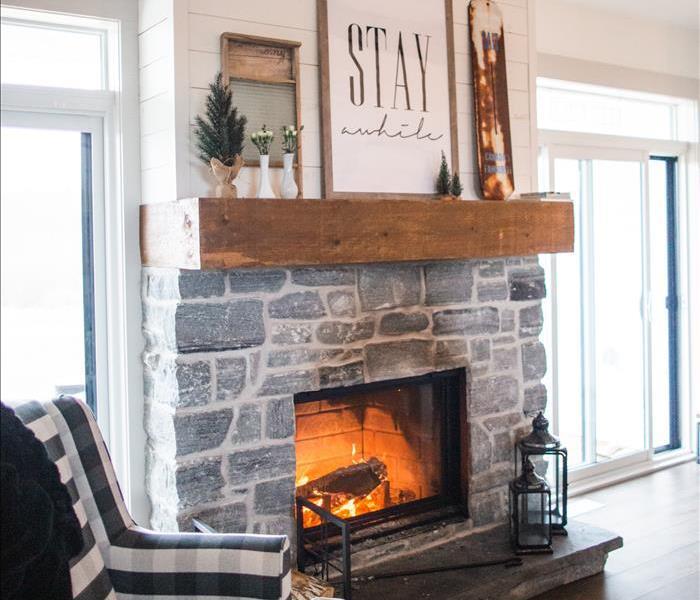 Never leave a fireplace or heater unattended.
Never leave a fireplace or heater unattended.
Fire Prevention Tips For Fall and Winter!
It's October, which means changing leaves and cooler temperatures. When the weather begins to cool down, we begin to see an increase in fires. Most of which are caused by space heaters, forgotten candles, or accidents in the kitchen. As you put out your decorations, space heaters, and your fall scented candles, keep these few safety tips in mind.
- If you leave the room, be sure to turn off heaters and extinguish candles.
- Keep anything that can burn at least 3 feet away from space heaters and open flames.
- Never plug-in heating equipment into an extension cord.
- Always place heaters on level flat surfaces on the ground.
- Never use the stove to heat your home or dry your clothes.
- Install and maintain carbon monoxide alarms.
- Never use a space heater or any appliance with a damaged or frayed cord.
- Have a qualified service professional inspect your heating system annually.
Dealing with fire damage can be stressful, let SERVPRO of Pickens County make it "Like it never even happened." Call (864) 855 - 3993!
Serve Up Fire Safety In The Kitchen!
10/5/2020 (Permalink)
Serve Up Fire Safety In The Kitchen!
We've finally reached fall! As the leaves change, temperatures drop, and the holidays get closer and closer, we will find ourselves in the kitchen more and more. October fourth through the tenth is fire prevention week. This year's theme is "Serve Up Fire Safety In The Kitchen!" Cooking equipment causes 49% of all home fires. We're sharing a few tips to help you prevent a fire from starting in your kitchen.
- Most fires that start in the home involve the stove. Stay in the kitchen while you are frying, boiling, grilling, or broiling food. Turn off the stove if you need to leave the kitchen for an extended length of time.
- Keep your cooking area free of oven-mitts, towels, wooden utensils, and food packaging.
- Keep little ones away from your cooking area. Make the kitchen a "kid-free zone."
- If you are sleepy, have consumed alcohol, or taken medication that makes you tired, don't cook.
- Always keep a lid. If a small grease fire starts, slide the lid over the pan. Leave the pan covered until it's cool.
- When in doubt, get out of the house! If you have any doubts about stopping a small kitchen fire, get out.
If you have a fire in your home, after the first responders leave, call SERVPRO of Pickens County (864) 855-3993!
5 Tips To Prevent House Fires
7/7/2020 (Permalink)
5 Tips To Prevent House Fires.
Your home is where you build your life and make memories with your family. It's the epicenter of your life. That's why you would do anything to keep your home safe from fire and smoke damage. Although you can't control everything that happens in your home, we've compiled a few tips to help reduce the risk of a fire starting in your home.
- Test your smoke alarms regularly:
The easiest way to avoid a house fire is to check your smoke alarms once a month. There is a button that you can press to test your alarm. If the alarm beeps weakly, then its time to change the batteries.
- Keep fire extinguishers around:
Your best defense if a fire breaks out is a fire extinguisher. Make sure you have one in every room that is a potential threat, like the kitchen.
- Inspect all heating sources:
Fires can be started by faulty heating sources. Have a professional check these annually.
- Practice caution with candles:
Keep candles far away from flammable objects such as blankets and candles. Never put them on uneven surfaces. Always put them out before leaving the room.
Before plugging anything in, make sure the cord isn't frayed or damaged. Damaged wires need to be replaced immediately.
If you have fire or smoke damage please call SERVPRO of Pickens County (864) 855-3993.
Simple Tips To Keep Your Thanksgiving Disaster Free
11/15/2019 (Permalink)
Simple Tips To Keep Your Thanksgiving Disaster Free!
Thanksgiving is quickly approaching, which means lots of fellowship, family time, and cooking in the kitchen. According to the U.S Fire Administration, an estimated 2,000 fires occur on Thanksgiving day. That is an average of five deaths, 25 injuries, and $21 million in property loss each year. The leading cause of these fires is cooking. SERVPRO of Pickens County wants you to have a safe and disaster-free Thanksgiving this year. Follow these simple and easy tips to keep your turkey day fire free!
- Ensure that you have smoke alarms on every level of your home, outside each sleeping area, and in every bedroom. Test your smoke alarms every month and replace them if they are 10 years old or older.
- Do not leave food unattended and keep a close watch on what you are cooking.
- Keep combustibles and oven food packaging away from burners and heat sources.
- Cooking oil can ignite quickly, watch it closely.
- Don't wear loose sleeves while cooking. Long sleeves can melt ignite or catch on handles of pots and pans spilling hot oil and other liquids.
- Have a "kid-free zone" of at least three feet around the stove and areas where hot foods or drinks are prepared or carried.
- Keep a lid nearby to smother small grease fires. Smother the fire by sliding the lid over the pan and turn off the stovetop. Leave the pan covered until it is completely cool.
Don't let fire and smoke ruin your holidays SERVPRO of Pickens County provides emergency services 24/7 - (864) 855 - 3993!
To learn more, please visit Thanksgiving Safety Tips
Keep Your Fall Fire Free!
10/10/2019 (Permalink)
Keep Your Fall Fire Free!
It's fall time! Which means cooler weather, beautiful colors, and an abundance of outdoor activities. Plan ahead this fall season to ensure its fire-free. Below are a few tips you can use to make sure you have a disaster-free fall.
Fall decorations, like dried flowers and cornstalks, are highly flammable. Keep these and other decorations away from open flames and heat sources, including light bulbs and heaters. Keep emergency exits clear of decorations, so nothing blocks escape routes. Teach children to stay away from open flames. Be sure they know how to stop, drop, and roll if their clothing catches fire. Remember safety first when choosing a Halloween costume. Consider avoiding billowing fabric. If you are making a costume, choose a material that won't easily ignite if it comes into contact with heat or flame. It is safest to use a flashlight or battery-operated candle in a jack-o-lantern. Use extreme caution if using a real candle. Place lit pumpkins away from anything that can burn and out of the way from doorsteps, walkways, and yards.
The Difference Between Safety and Tragedy.
10/8/2019 (Permalink)
The Difference Between Safety and Tragedy.
It's October which means, it's Fire Prevention Month. During this month, you should take the time to reevaluate your emergency preparedness plans for your home and business. Pay close attention to your fire escape plan. Ask yourself, do you have two exit strategies for each room? If a fire does start in your home or business, can you escape in two minutes? If not, then identify these obstacles and remove them or work around them. Creating, implementing, and practicing a fire escape plan for your home or business may be the difference between safety and tragedy! Eight percent of people surveyed said getting out was their first thought after hearing a fire alarm. Escape planning and practice can help you make the most of the time you have, giving everyone or business enough time to get out.
Fire Escape Plans and Fire Prevention Month
10/8/2019 (Permalink)
Fire Escape Plans and Fire Prevention Month.
It's October which means, it's officially Fire Prevention Month. The National Fire Protection Association (NFPA) sets aside a designated week each October to focus on fire prevention. During this month, evaluate your fire escape plans. The 2019 theme of Fire Prevention Month is "Not every hero Wears a Cape. Plan and Practice Your Escape!" According to the NFPA, once the fire alarm goes off, "you could have less than one to two minutes to escape safely!"
During a fire, every second counts. Fire experts agree; people have as little as two minutes to escape a burning home or business. Creating, developing, and practicing a fire escape plan in your home and office can make the difference between safety and tragedy. Draw a map of each level of your home or business and show all the doors and windows. Find two ways out to get out of each room. Make sure all doors and windows that lead outside open easily. Choose an outside meeting place that is a safe distance in front of your home or business, mark the location of the meeting area on your escape plan. Teach children how to escape on their own in case you cannot help them. Plan for everyone in your home or office, with special consideration for elderly or disabled individuals. Practice your fire escape plan at least twice a year in your home or business.
There Are Black Spider Webs In My House!
7/9/2019 (Permalink)
No those are not black spider webs or cobwebs you are seeing. These are actually called soot webs. After petroleum or synthetic materials burn soot forms and bonds together. You will typically see soot webs on the ceilings and in the corners of your home after a fire. Corners and ceilings usually have a cooler temperature and will collect more soot webs. As the air is seeking equilibrium, the webs will float towards higher areas with cooler temperatures. If you find soot webs in your home after fire don't attempt to remove them, as you can cause more damage to the wall or ceiling. Dealing with a fire is already stressful enough. Let SERVPRO of Pickens County handle the clean up for you. (864) 855 - 3993.
Tips To Prepare For a Fire In Your Pickens County Home
10/26/2018 (Permalink)
When a fire breaks out in your Pickens County home you only have two minutes to escape. It is important that you are prepared when a fire starts so that you can escape your home quickly and safely.
- Install the right amount of smoke alarms. Test them once a month and replace the batteries at least once a year.
- Teach children what smoke alarms sound like and what to do when they hear one.
- Ensure that all household members know two ways to escape from every room of your home and know the family meeting outside spot outside of your home.
- Establish a family emergency communications plan and ensure that all household members know who to contact if they cannot find one another.
- Practice escaping from your home at least twice a year. Press the smoke alarm test button or yell "Fire" to alert everyone they must get out.
- Make sure everyone knows how to call 9-1-1.
- Teach household members to STOP, DROP and ROLL if their clothes catch on fire.
The 7 Ways to Prepare for a Home Fire
Commercial Fire Damage Restoration For Pickens County
10/24/2018 (Permalink)
Commercial Fire Damage Restoration For Pickens County
Fire can spread quickly and destroy anything that is in its path. A fire can be especially devastating for any business or commercial property. In addition to the fire and smoke damage, significant water damage from firefighting efforts and fire suppression systems may occur. Equipment, machinery, offices, and products can be destroyed leaving you with a huge mess to deal with. Every hour spent restoring your business back to pre-fire condition is an hour of lost revenue and productivity. If your business experiences a fire loss, call the fire and water damage restoration experts and we will respond immediately to get you back to business.
- 24 Hour Emergency Service
- Faster to Any Size Disaster
- A Trusted Leader in the Fire and Water Restoration Industry with over 1,700 Franchises
- Highly Trained Fire and Water Damage Restoration Specialists
Commercial Fire Damage? Call Us Today - (864) 855-3993
Restoring Your Belongings After a Fire
10/15/2018 (Permalink)
Restoring Your Belongings After A Fire
After a fire, smoke, and soot affect not only the structure of your house but your belongings as well. SERVPRO of Pickens County understands your family's furniture, clothing, keepsakes, and other belongings make your house more than a structure; they make it a home.
Contents Restoration
A fire can be a stressful event to deal with. You may feel like you have lost everything. SERVPRO of Pickens County specializes in restoring your belongings, keepsakes and other contents after they have been damaged by a fire. Our expertise and "restore" versus "replace" mentality can help you save money while preserving your precious keepsakes that can't be replaced. We pretest your belongings to determine what items can be restored to pre-fire condition. We use several methods of cleaning to restore your belongings, including:
- Dry Cleaning - Used for cleaning light residues or to pre-clean prior to wet clean
- Wet Cleaning - This cleaning method removes moderate to heavy residues.
- Spray and Wipe - Used for items that cannot withstand wet cleaning.
- Foam Cleaning - Used for upholstery fabrics that might shrink or bleed if wet cleaned.
- Abrasive Cleaning - involves agitation of the surface being cleaned.
- Immersion Cleaning - Contents are dipped into a bath of the cleaning product.
If You Have Questions or Need Help, Call Us Today - (864) 855-3993
SERVPRO of Pickens County Fire Damage Restoration Process
10/8/2018 (Permalink)
SERVPRO of Pickens County Fire Damage Restoration Process
After the fire trucks leave, your home likely suffers from fire and smoke damage and extensive water damage from firefighting efforts. SERVPRO of Pickens County has the specialized fire restoration training needed to restore your home. Although every fire damage is a little different and requires a unique solution, the general process stays the same. The steps listed below outline our process for the "typical" fire damage emergency.
Step 1: Emergency Contact
When you call SERVPRO of Pickens County our restoration process begins. A representative will ask questions that will help us respond immediately with appropriate equipment and resources.
Step 2: Inspection and Fire Damage Assessment
We carefully inspect and test the adjoining rooms of your property to determine the extent of the fire, smoke, and soot damage.
Step 3: Immediate Board-Up and Roof-Tarp Service
Fire damage can often compromise windows, walls, and roofs. To maintain security and to protect against further damage, we can board up missing windows and walls and place tarps on damaged roofs.
Step 4: Water Removal and Drying (if water damage is present)
The water removal process begins almost immediately and removes the majority of the water. We then use dehumidifiers and air movers to remove the remaining water and complete the drying process.
Step 5: Removal of Smoke and Soot from All Surfaces
We use specialized equipment and techniques to remove smoke and soot from ceilings, walls, and other surfaces.
Step 6: Cleaning and Sanitizing
We clean, sanitize, and disinfect all of the restorable items and structures that were damaged by the fire. We use a variety of cleaning techniques to restore your belongings to pre-fire condition. We are also trained to remove odors using industrial air scrubbers and fogging equipment.
Step 7: Restoration
Restoration is the final step-getting your home or business to its pre-fire condition. Restoration may involve minor repairs, such as replacing drywall, painting and installing new carpet; or it may entail major repairs such as the reconstruction of various areas or rooms in your home or business.
Have Questions About Fire, Smoke, or Soot Damage? Call Today – (864) 855-3993
How To Create A Fire Escape Plan
8/14/2018 (Permalink)
How To Create A Fire Escape Plan
- Plan For Everyone: You should take into account the special needs of every member in your household. Young children and elderly family members may need extra assistance in case of a fire. Make sure someone is assigned to help them and choose a backup person in case the assigned person is away.
- Find Two Ways Out: Find two ways out of every room in your home. Include windows and doors in your plan, and make sure all escape routes can open easily so you can get outside.
- Involve Children In Planning: Consider having your children help create a fire escape plan. You can draw a map and of your home and have children mark at least two exit routes and the locations of the smoke detectors.
- Choose A Meeting Spot: Decide on a meeting place that is outside and is a safe distance away from your home. This meeting place should be in front of your house so emergency responders can see you upon arrival. Agree to not go back in the house after you leave.
- Check Smoke Alarms: Check that smoke detectors are properly placed and working.
- Be Visible: Make sure that your house number can be seen quickly from the street by first responders.
- Respond Quickly: Make sure that everyone knows that if the smoke alarm sounds, he or she needs to get out immediately.
- Have A Backup Plan: If the planned exit routes are blocked or it’s not possible to leave the house, close all doors between you and the fire. Put a towel under the door and go to an exterior-facing window. Call the fire department and report your location.
- Share With Everyone: Go over the plan with everyone who lives in the house and with visitors and overnight guests.
- Practice Regularly: Practice and review the plan regularly (at least one to two times a year).
How To Create A Fire Evacuation Plan
Fire And Smoke Damage In Your Pickens County Home
7/23/2018 (Permalink)
Fire And Smoke Damage In Your Pickens County Home
Once the fire department leaves, your Pickens County home may suffer from water damage caused by firefighting efforts. We have the specialized fire and water damage restoration training, personnel, and equipment to handle fire and water damage and can quickly restore your home to pre-fire condition. Below are some tips to protect you and your home after a fire.
Do:
- Limit movement in your home to prevent soot particles from being embedded into upholstery and carpets.
- Keep your hands clean. Hands covered in soot can further damage upholstery, walls, and woodwork.
- Place dry, colorfast towels or old linens on rugs, upholstery and carpeted areas.
- If electricity is off, empty your freezer and refrigerator completely and prop doors open to help prevent odor.
- Wipe soot off of chrome on kitchen and bathroom faucets, trim and appliances, then protect these surfaces with a light coating of lubricant.
- If heat is off during winter, pour RV antifreeze in sinks, toilet bowls, holding tanks and tubs to avoid freezing pipes and fixtures.
- Wash both sides of leaves on houseplants.
- Change HVAC filter, but leave the system off until a trained professional can check the system.
- Tape double layers of cheesecloth over air registers to stop soot particles from getting in or out of the HVAC system.
Don't:
- Don't attempt to wash any walls or painted surfaces without first contacting SERVPRO of Pickens County.
- Don't attempt to clean any electrical appliances that may have been close to fire, heat or water.
- Don't attempt to shampoo carpet or upholstered furniture.
- Don't eat any food or beverages that may have been stored close to fire, heat, or water.
- Don't turn on ceiling fixtures if ceiling is wet. Wiring may be damaged or wet and can cause electric shock, and air movement can create secondary damage.
- Don't send garments to an ordinary dry cleaner. Improper cleaning may set smoke odor.
We’re Faster to Any Size Disaster – (864) 855-3993



 24/7 Emergency Service
24/7 Emergency Service


